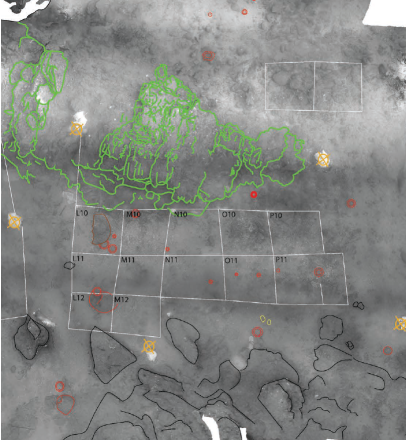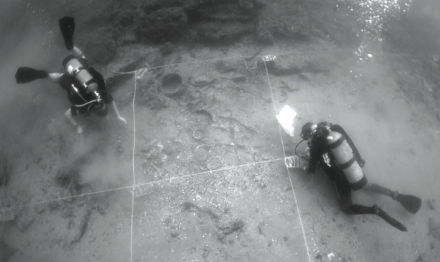History
The Godavaya shipwreck was discovered in 2003 by local Sinhalese fishermen B.G. Preminda and Sunil Ratnaweerapatabandige. It includes a concreted mound of corroded metal bars and a scattering of other ancient cargo, including glass ingots and pottery, that have tumbled around on the seafloor for hundreds of years amid strong currents. The wreck is probably the oldest known shipwreck in the Indian Ocean.
Description
Status
Research history
A short preliminary campaign caried out in 2010 brought to light the remains of a sunken cargoship dated between 1st century B.C. and the 1st century AD.
It was caried out by an international team comprised of experts in diving and underwater archaeology from Sri Lanka, India, Indonesia, Malaysia and the Philippines. The main objective of the exploration was to make assessment of the wreck site based on the data generated during the fieldwork. A.D.¹

Site plan during the excavation of 2014
The first season of full-scale excavation of the Godavaya shipwreck was launched in 2012-2013 with a collaborative, multinational team of two dozen students and maritime archaeologists from the United States, France, Sri Lanka (DOA and CCF*) and Turkey who worked under the guidance of field directors Matthews and Trethewey.
In the spring of 2014, with financial support from the National Endowment for the Humanities (NEH), INA launched its longest ever archaeological field season at Godavaya.²

The DOA is the governmentally-sanctioned archaeological authority in Sri Lanka. CCF was established in 1982 with funding from UNESCO, tasked with preservation of the country’s historical monuments.
References
- DEBORAH CARLSON, ORKAN KÖYAĞASIOĞLU, AND STACI WILLI (2015).
The ancient shipwreck excavation at Godavaya Sri Lanka.
The INA Quarterly volume 42, 2. - Muthucumarana,R. (2011).
Preliminary assessment of an early historic (2000 year old) shipwreck at Godawaya, Sri Lanka.
Bulletin of the Australasian Institute for Maritime Archaeology, 35.